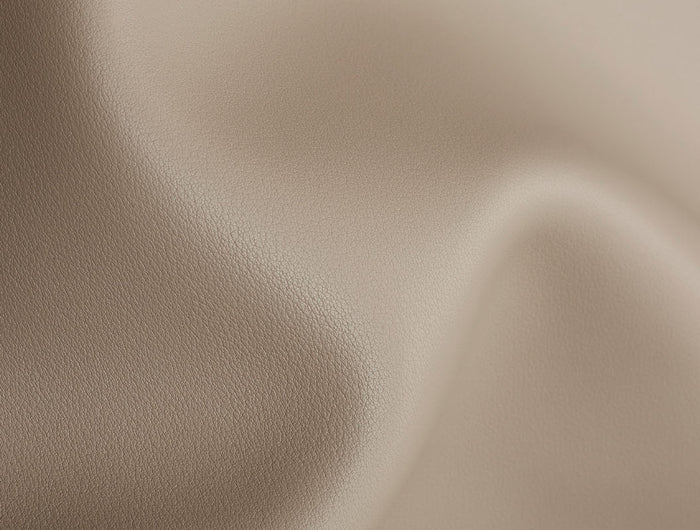
We all know that cowhide is thick and can be peeled in many layers. Simply put, it can be divided into top layer cowhide and second layer cowhide (also known as regenerated cowhide). Our second layer cowhide materials are mainly divided into three types:

Two layer solvent-free craft cowhide
Solventless leather: Solventless leather is a method of drying at high temperature based on the principle of natural reaction between two resins without adding catalysts. The raw materials used in production do not add any low boiling organic solvents, and the polyols in the original solution are modified and connected to different types of material systems, providing new technological breakthroughs in the production process. There is no waste gas or wastewater generated during the production process, and zero emissions are achieved. Its advantages are: environmental protection. In terms of environmental protection, zero solvent PU leather has fully passed the REACH hazardous materials and POHS heavy metal detection of SGS, truly achieving five zeros: zero solvent, zero plasticizer, zero emission, zero odor, and zero metal.

Two layer wet process cowhide
Two layer wet process cowhide is also a type of genuine leather. The inspection report is as follows: cow split layer transfer mold leather, with the middle layer being the wet process layer, and the bottom layer being the cowhide peeled off with wet hair embryo. The high-quality two-layer cowhide retains the original physical properties of the cowhide. The advantages of being able to double layer cowhide are: high tearing strength, tensile strength, good folding resistance, ability to mark logos, good cold resistance, good resistance to mold, thick and plump finished products, good simulation, low VOC (volatile organic compounds) content, etc. The surface is easy to clean and the organizational structure is similar to natural leather; The overall leather yield of its leather surface is very high.

Two layer leather veneer technology cowhide
The simplified surface layer of the leather patch process is PU artificial leather with a bottom layer of cow cut leather. It was first invented as a substitute for leather fabrics, and is made by pressing and laminating PVC with plasticizers and other additives on the fabric. The advantages are cheap price, rich colors, and various patterns, while the disadvantages are easy to become hard and brittle. PU synthetic leather is used to replace PVC synthetic leather, and its price is higher than PVC synthetic leather. In terms of chemical structure, it is closer to leather fabric. It does not require plasticizers to achieve soft properties, so it does not become hard or brittle. At the same time, it has the advantages of rich colors and diverse patterns, and the price is cheaper than leather fabric, so it is popular among consumers. Its price is relatively cheap and its utilization rate is high. It is also made into various grades of varieties with changes in technology, such as imported two-layer cowhide, due to unique technology, stable quality, and novel varieties.
 What is two-layer leather?
What is two-layer leather?
Double layer leather: It is made by slicing thick leather with a leather slicing machine, and the first layer is used to make full grain leather or trimmed leather. The second layer is made of double layer leather through a series of processes such as coating or film application. Its fastness and wear resistance are poor, making it the cheapest type of leather in the same category. Two layer cowhide is a leather made by wet processing of cow suede and adding PVC and PU materials for re bonding. It is suitable for making leather products and looks very high-end, with no difference in appearance from the top layer leather.
Characteristics of two-layer cowhide: The reverse side is the second layer of cowhide material, which is coated with a layer of PU resin on the surface, so it is also known as filmed cowhide. It is also made into various grades of leather with changes in technology, such as imported two-layer cowhide. Due to its unique craftsmanship, stable quality, and novel varieties, it is currently a high-end leather with a price and grade no less than that of the top layer genuine leather. Cowhide can be divided into two layers: the first layer and the second layer, which are composite cowhide. The first layer of cowhide is the epithelial layer of the cow's body, with original skin features on the surface, clear pores and skin texture. It is composed of a fiber layer similar to villi (each layer of cowhide has individual differences in fiber density and length), as well as a slightly loose transition layer closely connected to it, which has good strength, elasticity, and process plasticity. Composite cowhide, also known as two-layer cowhide but not the leather on the cow's body, is made by breaking the scraps of the first layer of leather and adding polyethylene material to re fit it. Then, it is sprayed with chemical materials or coated with PVC or PU film on the surface to make it. It still retains the characteristics of cowhide, but its wear resistance and strength are not as good as the first layer of cowhide. The first layer of leather should be divided into first level head layer cowhide, second level head layer cowhide, and third level head layer cowhide. The second layer of cowhide is a composite cowhide, also known as broken leather. Composite cowhide, also known as transfer cowhide, is a two-layer cowhide that is smooth, shiny, and wrinkle free.
 What is the difference between two-layer leather and top layer cowhide?
What is the difference between two-layer leather and top layer cowhide?
Head layer cowhide: Like cow skin, it has pores, fine lines, good breathability, and most importantly, it has elasticity and ductility, and is very wear-resistant. Cowhide is priced in feet, and in the raw material market, the price of smooth layer cowhide ranges from tens to hundreds of yuan. For cars that use the first layer of leather, it must be a very high-end car, such as the BMW 5 series (usually only available in high-end models), and domestic cars are mostly made of second layer leather.
Double layer cowhide: also known as regenerated cowhide, a common double layer cowhide is made by breaking the leftover materials of cowhide and adding polyethylene material to re fit it. Then, the surface is sprayed with chemical materials or coated with PVC or PU films for processing.
 Is the second layer of leather genuine leather?
Is the second layer of leather genuine leather?
Two layer cowhide belongs to a type of genuine leather, but it is inferior to the top layer cowhide. The common genuine leather on the market is mostly double skin. Generally, furniture sofas are made of double-layer leather, but there are relatively few leather shoes made of recycled leather (due to the poor strength of double-layer leather and the limited material used for leather shoes, a set of sofas can be made of many pairs of shoes). Therefore, only extremely cheap leather shoes or partially spliced leather shoes should be used with double-layer leather.
 Will the second layer of cowhide peel off after prolonged use
Will the second layer of cowhide peel off after prolonged use
Two layer cowhide is a type of genuine leather that generally does not experience peeling! If it is a real sanded skin, the phenomenon of keratin layer falling off will occur, which is the situation we usually see when sanded skin becomes smoother after wearing for a long time. As long as the second layer of cowhide is well maintained, it generally does not peel off.

